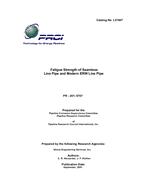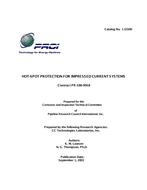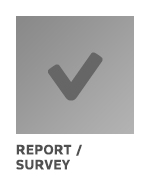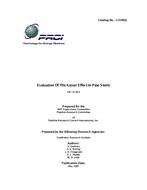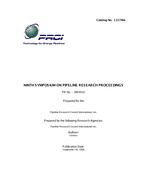Provide PDF Format
PRCI PR-201-9707
- Fatigue Strength of Seamless Line Pipe and Modern ERW Line Pipe
- Report / Survey by Pipeline Research Council International, 09/01/2001
- Publisher: PRCI
$198.00$395.00
L51847e
Stress Engineering Services, Inc.
Need: There is ample evidence that the amount of ERW pipe used both historically and currently in pipelines greatly exceeds the amount of seamless pipe. Among other things, this disparity is reflected in the fact that the numbers of manufacturers of ERW line pipe greatly exceeds the number of manufacturers of seamless line pipe. Nevertheless, because of the quality issues associated with early ERW pipe, a persistent belief exists, on the part of some line-pipe users, that pipes with longitudinal weld seams will not perform as well as seamless pipe especially in terms of resistance to cyclic stresses. In transmission pipelines, the cyclic stresses are typically induced by pressure fluctuations generated by either pumps or compressor stations.
Benefit: To resolve the question as to whether or not ERW pipe might prove inferior to seamless pipe in terms of resistance to cyclic stresses, the PRCI member companies decided to fund the project described herein to assess the performance of ERW pipe versus seamless pipe. Presented herein are the results of a research project on the serviceability of seamless line pipe and modern high-frequency-welded ERW (electric-resistance-welded) line pipe. Full-scale samples of both kinds of pipe were subjected in a laboratory environment to pressure cycles simulating hundreds of years of service. Four samples of ERW pipe and one sample of seamless pipe were tested. Each sample consisted of a 20-foot length of the material fabricated with end caps. Coupons were cut from the remaining pieces to accommodate tensile and impact tests and base-metal metallography. The 20-foot specimens were subjected to pressure cycles ranging from a minimum of 100 psig to the pressure level corresponding to 46 percent of the measured ultimate tensile strength of the material.
Result: From this work, it is concluded that the bondline region of a modern, high-frequency-welded line pipe material does not limit the serviceability of the pipe as long as the bondline region is free of significant defects. It follows that there is no reason to prefer seamless pipe over ERW pipe from the standpoint of pipeline safety and integrity as long as the ERW seam of the material is free of injurious defects. It is further concluded that the fatigue lives of line-pipe materials in terms of pressure cycles greatly exceed the anticipated service lives of all pipelines. The key to avoiding pressure-cycle-induced fatigue failures in pipelines is to assure that the pipelines are free of injurious defects that could lead to premature fatigue crack initiation and growth in response to service pressure cycles.
Stress Engineering Services, Inc.
Need: There is ample evidence that the amount of ERW pipe used both historically and currently in pipelines greatly exceeds the amount of seamless pipe. Among other things, this disparity is reflected in the fact that the numbers of manufacturers of ERW line pipe greatly exceeds the number of manufacturers of seamless line pipe. Nevertheless, because of the quality issues associated with early ERW pipe, a persistent belief exists, on the part of some line-pipe users, that pipes with longitudinal weld seams will not perform as well as seamless pipe especially in terms of resistance to cyclic stresses. In transmission pipelines, the cyclic stresses are typically induced by pressure fluctuations generated by either pumps or compressor stations.
Benefit: To resolve the question as to whether or not ERW pipe might prove inferior to seamless pipe in terms of resistance to cyclic stresses, the PRCI member companies decided to fund the project described herein to assess the performance of ERW pipe versus seamless pipe. Presented herein are the results of a research project on the serviceability of seamless line pipe and modern high-frequency-welded ERW (electric-resistance-welded) line pipe. Full-scale samples of both kinds of pipe were subjected in a laboratory environment to pressure cycles simulating hundreds of years of service. Four samples of ERW pipe and one sample of seamless pipe were tested. Each sample consisted of a 20-foot length of the material fabricated with end caps. Coupons were cut from the remaining pieces to accommodate tensile and impact tests and base-metal metallography. The 20-foot specimens were subjected to pressure cycles ranging from a minimum of 100 psig to the pressure level corresponding to 46 percent of the measured ultimate tensile strength of the material.
Result: From this work, it is concluded that the bondline region of a modern, high-frequency-welded line pipe material does not limit the serviceability of the pipe as long as the bondline region is free of significant defects. It follows that there is no reason to prefer seamless pipe over ERW pipe from the standpoint of pipeline safety and integrity as long as the ERW seam of the material is free of injurious defects. It is further concluded that the fatigue lives of line-pipe materials in terms of pressure cycles greatly exceed the anticipated service lives of all pipelines. The key to avoiding pressure-cycle-induced fatigue failures in pipelines is to assure that the pipelines are free of injurious defects that could lead to premature fatigue crack initiation and growth in response to service pressure cycles.
Related Products
PRCI PR-138-9724
Gas Transmission Industry Experience Of Turbine Parametric Emission Monitoring Systems (PEMS)..
$6.00 $12.00

